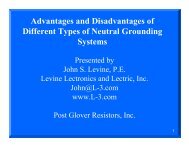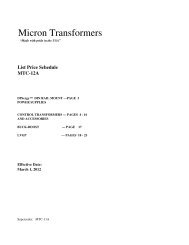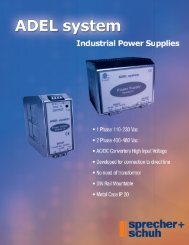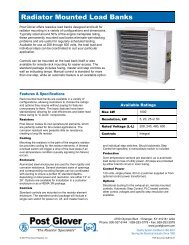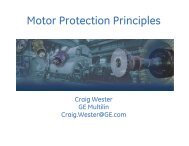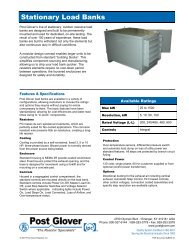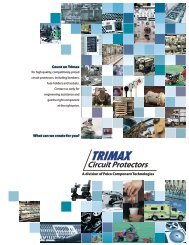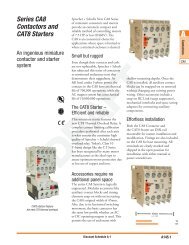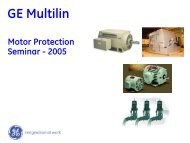IEEE Hybrid Grounding
IEEE Hybrid Grounding
IEEE Hybrid Grounding
You also want an ePaper? Increase the reach of your titles
YUMPU automatically turns print PDFs into web optimized ePapers that Google loves.
GROUNDING AND GROUND FAULT PROTECTION OF MULTIPLE<br />
GENERATOR INSTALLATIONS ON MEDIUM-VOLTAGE<br />
INDUSTRIAL AND COMMERCIAL POWER SYSTEMS<br />
PART 1 – THE PROBLEM DEFINED<br />
An <strong>IEEE</strong>/IAS Working Group Report<br />
[Working Group Members] - Prafulla Pillai (Chair), Alan Pierce, Bruce Bailey, Bruce Douglas,<br />
Charles Mozina, Clifford Normand, Daniel Love, David Shipp, Gerald Dalke, James R. Jones, Jay<br />
Fischer, Jim Bowen, Lorraine Padden, Louie Powell, Neil Nichols, Ralph Young, Norman T.<br />
Stringer<br />
Working Group Chair:<br />
Prafulla Pillai<br />
Kellogg Brown & Root, Inc.<br />
Houston, Texas 77002<br />
Abstract - The paper discusses typical grounding practices<br />
and ground fault protection methods for medium voltage<br />
generator stators, highlighting their merits and<br />
drawbacks. Particular attention is given to applications of<br />
multiple generators connected to a single bus. The paper<br />
also provides an overview of the generator damage<br />
mechanism during stator ground faults. Problem areas<br />
associated with each type of grounding are identified and<br />
solutions are discussed. The paper also provides a list of<br />
references on the topic. The paper is intended as a guide<br />
to aid engineers in selecting adequate grounding and<br />
ground fault protection schemes for medium voltage<br />
industrial and commercial generators for new<br />
installations, for evaluating existing systems, and for<br />
future expansion of facilities, to minimize generator<br />
damage from stator ground faults. These topics are<br />
presented in four separate papers, Part 1 through Part 4.<br />
Part 1 covers scope, introduction, user examples of stator<br />
ground failure, and theoretical basis for the problem. Part<br />
2 discusses various grounding methods used in industrial<br />
applications. Part 3 describes protection methods for the<br />
various types of grounding and Part 4 provides a<br />
conclusion and bibliography of additional resource<br />
material.<br />
I. SCOPE OF PAPER<br />
In recent years severe damage to bus-connected<br />
generators from stator ground faults has been observed in<br />
numerous industrial plants. Such generator failures may<br />
require extensive stator lamination repairs at the<br />
manufacturer’s premises with the associated down time. The<br />
primary objective of this paper is to present methods of<br />
protecting medium-voltage industrial generators against<br />
extensive and expensive stator iron damage from internal<br />
ground faults. The paper will review the issues associated<br />
with various grounding practices and ground fault protection<br />
methods to minimize iron damage.<br />
The paper summarizes some basic considerations in<br />
selecting grounding and ground fault protection of<br />
generators installed on medium voltage power systems with<br />
multiple ground sources and serving load directly at<br />
generator terminal voltage. The discussions also apply to<br />
generators installed in parallel with utility transformers.<br />
However, the paper excludes installations with special<br />
grounding requirements such as Independent Power<br />
Producer (IPP) connections and mining applications. Also,<br />
rotor ground faults are outside the scope of this paper.<br />
The paper will:<br />
a) Discuss factors requiring consideration in selecting<br />
grounding and ground fault protection schemes for mediumvoltage<br />
industrial generators<br />
b) Identify problem areas associated with grounding and<br />
ground fault protection of generators, especially for multiple<br />
units operating in parallel on medium-voltage industrial<br />
power systems<br />
c) Provide alternate solutions to the identified problems<br />
d) Identify items to be addressed in detail in future<br />
working group papers<br />
The paper is organized into four parts. Part 1 covers<br />
scope, introduction, user examples of stator ground failure,<br />
and theoretical basis for the problem; Part 2 discusses<br />
various grounding methods used in industrial applications;<br />
Part 3 describes protection methods for the various types of<br />
grounding; and Part 4 provides a conclusion and<br />
bibliography.<br />
0-7803-7931-4/03/$17.00 © 2003 <strong>IEEE</strong> 56



